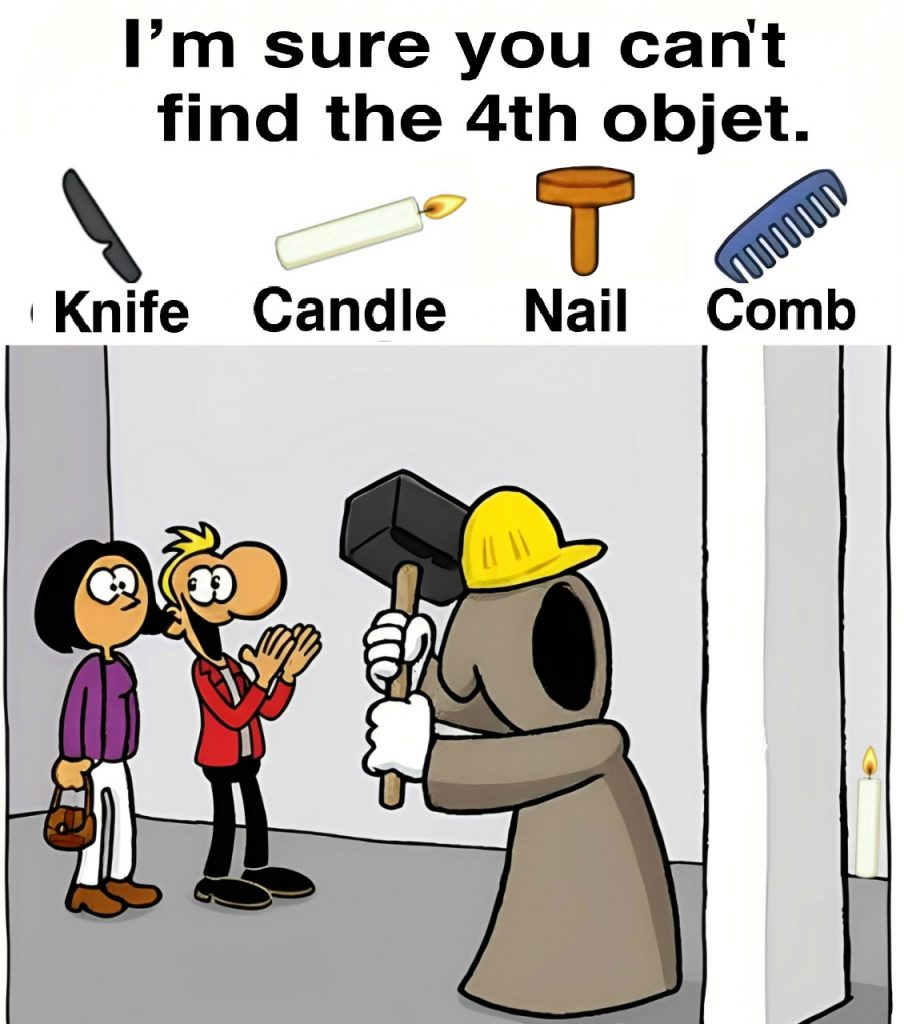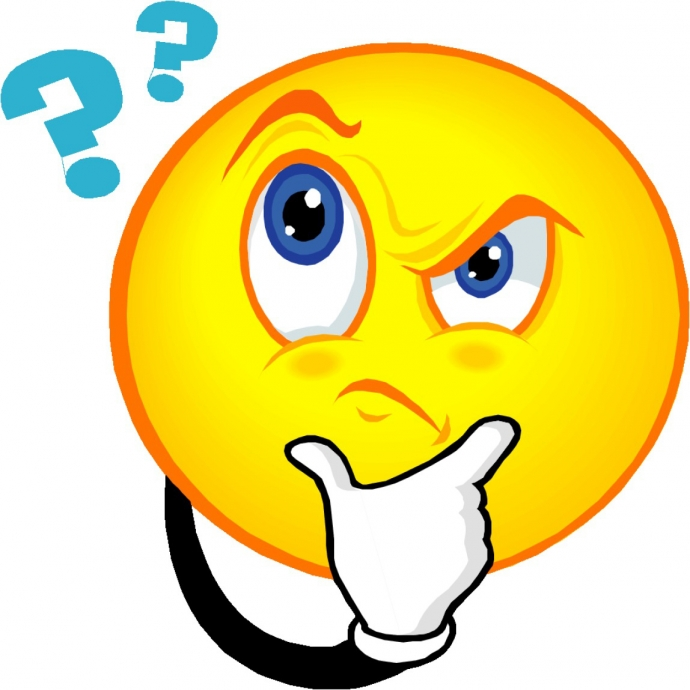Can You Spot All Four Hidden Objects?
Take a good look at the picture. Somewhere inside this funny scene, a knife, a candle, a nail, and a comb are cleverly hidden. At first glance, it just looks like a construction worker with a big hammer, and two people watching. But the more you stare, the more your brain starts to notice strange little details.
So here’s the challenge:
Can you find all four objects on your own before you read the full breakdown?
Pause for a moment, zoom in if you can, and give yourself a honest try. Then come back and see how many you got right.

Why These Visual Puzzles Are So Tricky
You might be thinking, “It’s only four objects, how hard could it be?” But that’s exactly why this kind of puzzle is so sneaky. It uses a few psychological tricks to fool your eyes and your attention.
Here are some of the most common mistakes people make:
We look for full shapes, not disguised ones
Most people search for a clear knife, a clear candle, and so on. But in this puzzle, each object is blended into something else—like clothing, tools, or accessories. Because the shapes are partially hidden or stylized, your brain doesn’t immediately recognize them.
We focus on the center and ignore the edges
Our eyes naturally drift toward the main action in the picture—the big hammer, the faces, the central movement. That means the sides of the image, the small bag, and the folds of clothing often get ignored. And of course, that’s exactly where some objects are hidden.
We rush because we want to “win” the challenge
When a picture tells you “I’m sure you can’t find the 4th object,” it activates your competitive side. You start scanning quickly, convinced you’ll prove it wrong. But the faster you go, the more little details you miss, especially those hidden in shadows or folds.
Video : I’m sure you can’t find the 4th object?
We assume every detail is just decoration
The artist of this puzzle uses normal-looking items—like a belt, a shirt fold, or a handbag—to hide the key objects. Since those things belong in the scene, your brain treats them as background instead of clues. To solve it, you have to switch from casual looking to intentional searching.
Ready to see where everything is? Let’s walk through it step by step.
Step 1: Finding The Knife
Start with the most obvious place: the construction worker and his huge hammer. At first, it just looks like a regular hammer head. But take a closer look at the dark shape on the side of it.
Hidden inside the hammer head, you can see the clear outline of a knife. The blade is blended into the black area, cleverly shaped to look like part of the tool. Once you notice it, you can’t unsee it—there’s the handle, and the blade pointing downward.
So the first object is:
- Knife – hidden in the hammer head.
Many people miss this one because they assume the hammer is just a hammer. The trick is to ask yourself, “Does any shape here look like it could be something else?”
Step 2: Spotting The Candle
Next, check the background around the worker. Don’t just stare at the characters—look at the walls as well.
On the right side of the image, along the edge of the white wall, there’s a slim vertical shape that doesn’t quite match the rest. That’s because it’s actually a candle. You can see the small flame on top and the lighter-colored body of the candle running down the wall’s edge.

So the second object is:
- Candle – hidden on the right side, along the wall behind the worker.
This one disappears easily into the background because its color is close to the wall, and your eyes are busy watching the hammer in the middle.
Step 3: Tracking Down The Nail
Now shift your attention to the woman on the left. She’s holding a brown handbag in her hand. Most people see it as a simple accessory and move on—but this is where the artist gets clever.
Look closely at the bag. There’s a small, thin shape placed on it that doesn’t look like a normal design or buckle. That slender piece is actually the nail.
So the third object is:
- Nail – hidden on the woman’s handbag.
Instead of floating somewhere random, the nail is disguised as a little detail on an everyday object. It blends so well that you might only notice it when you slow down and examine the bag carefully.
Step 4: Discovering The Comb
Now take a closer look at the man in the red shirt standing next to her. At first, nothing seems strange. He’s just watching the worker with his hands together.
But check the bottom of his shirt, near the edge where it overlaps his pants. The folds and color lines form an object shape—and if you pay attention, you’ll see the outline of a comb hidden in the lower part of his shirt.
So the fourth object is:
- Comb – hidden along the edge of the red shirt.
Because the comb shares the same general color and direction as the shirt lines, your brain logs it as “just a wrinkle” unless you intentionally look for the comb’s teeth.

Why This Step-By-Step Approach Works
Notice the method we just used:
- Start with the main action (the hammer)
- Then search the background
- Then scan accessories (bag, clothes)
- Finally, inspect lines and folds for disguised shapes
This approach forces you to examine the entire scene in layers instead of just glancing around randomly. It’s a great strategy for any hidden-object puzzle, not just this one.
Did You Find Them Before Seeing The Answers?
Now that you know the solutions, think back to your first impression:
- Which object did you spot first?
- Which one took you the longest to find—the nail, the comb, or the candle?
- Did you overlook the knife because you assumed the hammer couldn’t hide anything?
These reflections are fun, but they also say something about how your brain works. Some people naturally focus on faces, others on clothes, others on the environment. That’s why different people spot different objects first.
Join The Fun: Share Your Experience
Now it’s your turn to jump into the conversation:
- Comment how many objects you found before reading the explanation.
- Tell us which one tricked you the most.
- Challenge a friend and see who spots all four faster.
Video : Can You Spot the Missing 4th Object?❤️👇🏻
You can even time yourself on the next puzzle and try to beat your own record.
Keep Training Your Brain With More Puzzles
Hidden-object challenges like this may look simple, but they’re actually great mini-workouts for your brain. They help you:
- Sharpen your concentration
- Improve visual memory
- Train your attention to detail
- Strengthen logical observation skills
So don’t stop here. Try more picture puzzles, “find the difference” games, and visual riddles. The more you practice, the more you’ll notice those tiny details everyone else skips.
Next time you see a challenge that says, “I’m sure you can’t find it,” you’ll smile—because now you have the skills, the patience, and the strategy to prove it wrong.